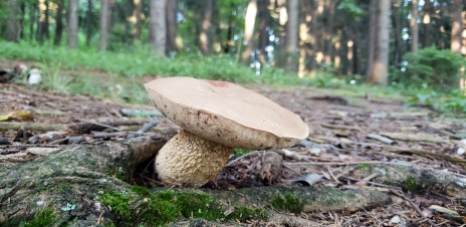In North American, when you mention mushroom hunting, everyone thinks about springtime Morel mushroom hunting. Sure, it is fun to seek out the elusive Morel and they are delicious, but this short season is only the beginning of the nature treasure hunt each year. One mushroom that makes mushroom hunters and foodies excited is the Boletus edulis mushroom. Commonly known as Porcini, Steinpilze, and Ceps mushrooms in Europe, the Boletus edulis mushroom is certainly a prize to find.
In Western Pennsylvania there are two times of the year to find these mushrooms – the spring and the fall. There are also look-a-like mushrooms that grow right along side them, so it helps to learn some of the differences.
Boletus edulis vs. Tylopilus felleus
I went for a hike in a grove of spruce trees and from a distance, I saw this monster mushroom. I couldn’t believe my luck. I was only 5 minutes into my hike and I had found what I was looking for – or so I initially thought. It was a brown mushroom with a spongy pore surface which places it into the right category, but I had to check a few more things to confirm the identity.
The easiest way to quickly tell the difference is to take a small bite of the mushroom cap to see if it is bitter or not. Keep in mind that you are not ingesting the mushroom, just simply tasting it and then spitting it out. It will be sharply bitter if it is Tylopilus felleus. Unfortunately, this particular individual was quite bitter – a bitter disappointment.
If I hadn’t wanted to taste it, there are a couple other characteristics that easily separate it from Boletus edulis.
- The pore surface on T. felleus bruises brown when handling / B. edulis does not.
- T. felleus has substantial brown reticulation on stem / B. edulis has white reticulation on stem.
Note: Boletus edulis is a name that likely covers multiple similar species in North America. More study needs to be done to separate them.
Here are two varieties that I have found within the Boletus edulis group. Using the macro characteristics and environmental details compared against the research documentation that others have done, here are my best guesses (with photos)
Boletus rex-veris (best guess)
This was found under a spruce grove. Although the colors change with age, in this button stage the cap is brown/orange/cinnamon colored with white pores. The pore surface doesn’t rapidly bruise when handled or cut. The white reticulation on the stipe does bruise brown when handling it. The taste was not bitter.
I did not find any details from other’s research to confirm the chemical test results, but when I used Ammonia on the stipe, it turned a lilac color. KOH (Potassium Hydroxide) on the stipe, it turned an orange color.
Boletus variipes var. fagicola (best guess)
This mushroom was found under a group of oak trees in Southwestern Pennsylvania. The pore surface did not bruise or change colors based on handling or cutting. The stem on this particular one was covered with a white reticulation. The taste was not bitter.
Unfortunately, I didn’t do any further tests or make any further observations about this. I will be headed back to the same spot this year to try to find more.
This mushroom hunting season has just begun. Stayed tuned for more fungi finds!















